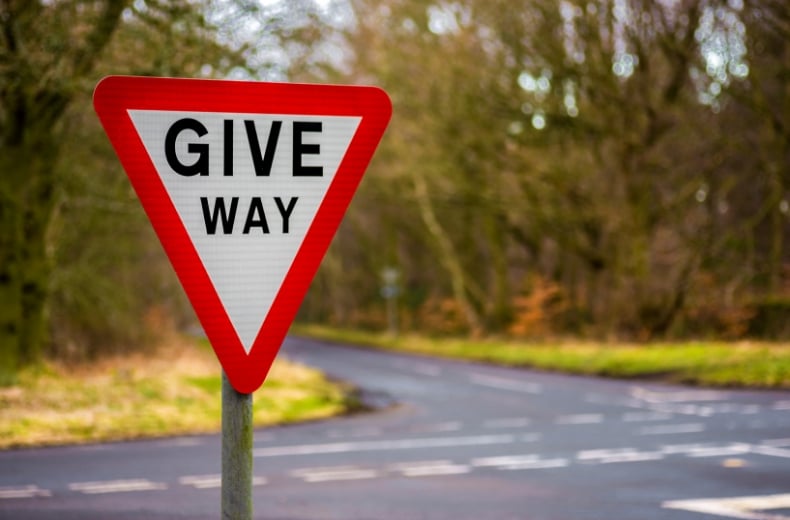It’s especially important if you’re recently passed your test, as you won’t have direct experience of every different type of road layout.
The safer you are, the more you can potentially save on new driver insurance too, so it actually pays to know your road signs. Let’s start with the basics.
Different shapes have different meanings
There are hundreds of different road signs, each with their own meaning. However, most fall into one of three categories based on their shape. The general rule is:
- Circular road signs: Circular signs give orders - they must be followed to stay within the law. Circles with a red border tell you what you must not do (e.g. take a U-turn). Blue circles usually give a positive instruction, such as ‘turn left ahead’.
- Triangular road signs: Triangular signs warn. Road signs in the shape of an equilateral triangle are designed to warn you about the road layout or any hazards that lie ahead, such as sharp bends. They almost always have a red border.
- Rectangular road signs: Rectangular signs inform. Blue rectangular signs give information on motorways, green signs direct you on primary roads, while white signs give directions on minor roads. Rectangular signs can also indicate bus lanes and congestion charge zones.
Many road signs, such as speed limits, should be self-explanatory; but some aren’t quite so straightforward.
Here, we look at a few of the most common traffic signs in more detail – and some that are commonly misunderstood.
‘National speed limit applies’ sign
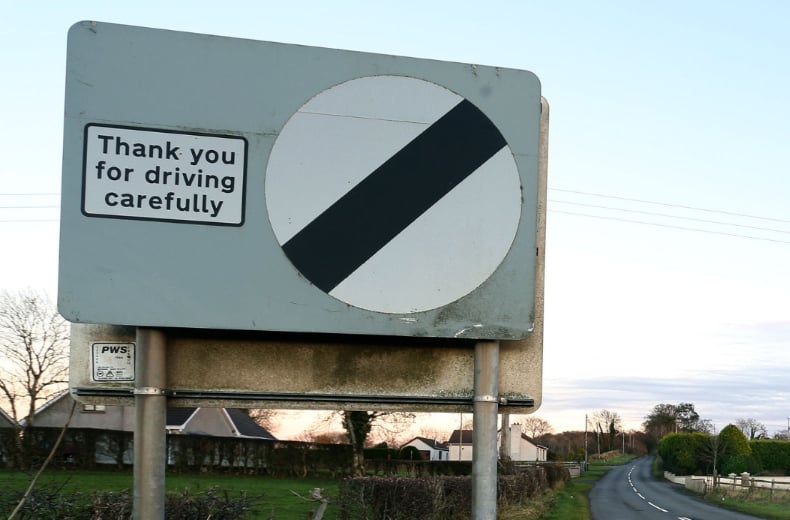
A white circular sign with a single black diagonal stripe through it tells you that the national speed limit applies on the upcoming stretch of road. It supersedes any previous speed limit signs you may have had to adhere to, such as passing through temporary roadworks. But what are the national speed limits?
- Built-up area: On a road where there are street lamps placed no more than 200 yards apart, the speed limit is 30mph for all vehicles.
- Single carriageway: For cars, the speed limit is 60mph, and 50mph for vans or if you’re towing a trailer/caravan.
- Dual carriageway and motorway: It’s 70mph for cars and vans under 7.5 tonnes maximum laden weight, but 60mph if you’re towing a trailer/caravan.
Of course, even when the national speed limit applies, it might not always be safe to drive at that speed, so use your common sense on this.
‘Maximum speed’ sign
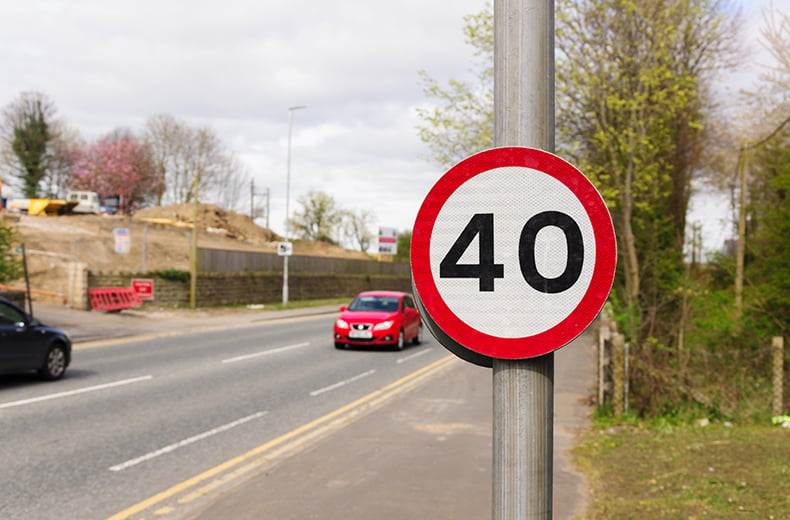
One of the most common road signs you’ll encounter – it displays the maximum speed permitted on a road within a red circle.
It will often appear with the word ‘ZONE’ written underneath with a local authority-selected image, to show you’re entering a local speed zone.
You’ll also see the sign as you leave a local speed zone. Look out for the words ‘ZONE ENDS’ and a diagonal stripe through the speed limit zone you’re leaving.
'Speed camera' sign
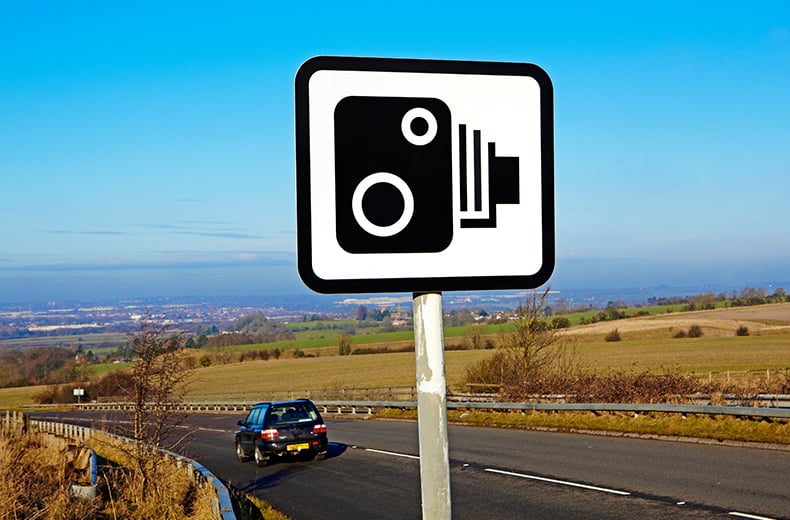
Or to give this sign it's full title: ‘area in which cameras are used to enforce traffic regulations’ sign. These will often appear with national speed limit signs and maximum speed signs.
A black camera symbol appears on a white background on sections of road covered by speed cameras and average speed cameras.
‘Give way to traffic on major road’ sign
This triangular sign is one of the most frequently seen on UK roads and is used to warn you of a junction ahead. Traffic on the road you will be joining has priority, so you must wait for a safe gap before continuing.
There are two types of Give Way sign – either with distance in yards to the junction under the sign, or with the words written in the middle of the sign.
You’ll notice that the triangle is upside down compared with other warning signs. That’s so it can still be recognised if it gets defaced by snow, for example.

Cheaper than AA or we’ll beat by 20%^
• Roadside cover from £5.49 a month*
• We get to most breakdowns in 60 mins or less
• Our patrols fix 4/5 breakdowns on the spot

‘No stopping’ sign
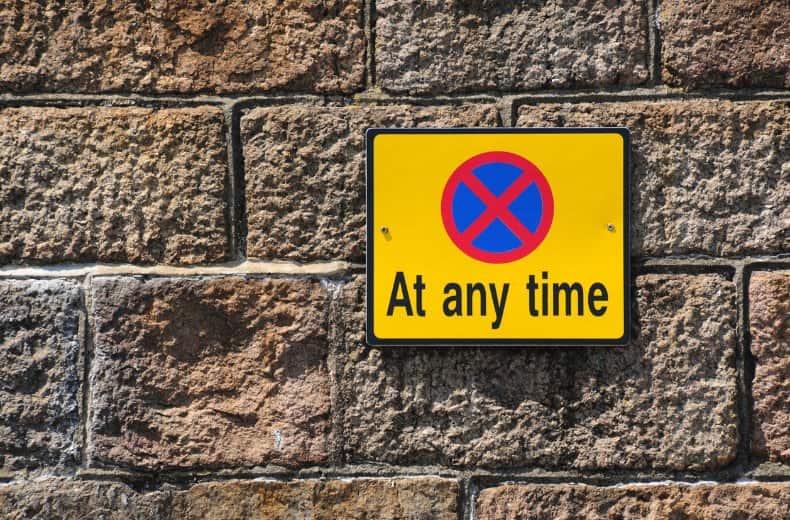
A red cross over a blue background indicates a clearway, which means you’re not allowed to stop – not even to set down or pick up passengers.
In some instances, restrictions may only apply at certain times of the day. You tend to see this sign on major commuter roads, such as Red Routes, or outside schools.
This is one of the most commonly misunderstood signs, and many drivers have fallen foul of the law by parking on a clearway.
‘No waiting’ sign
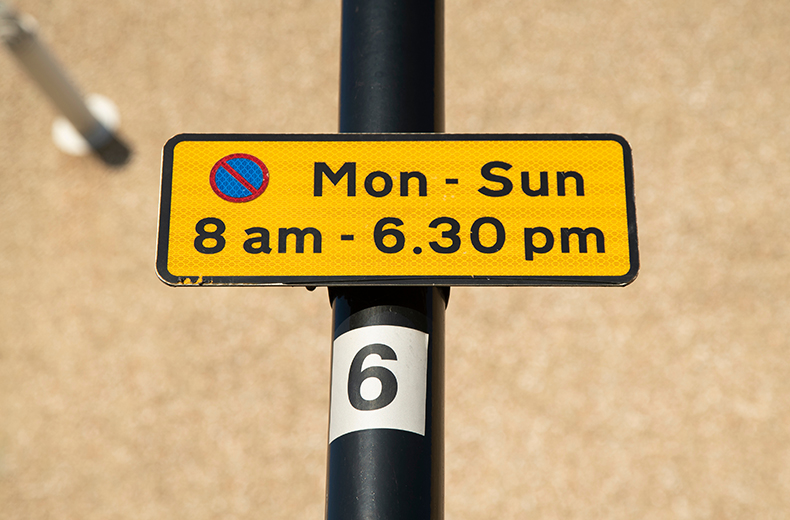
‘No waiting’ signs are easily confused with ‘no stopping’ signs. Rather than displaying a red cross they feature a single diagonal red stripe on the same blue background.
Drivers are allowed to drop off or pick up a passenger in a no waiting zone, although anything longer is prohibited.
The signs are almost always used alongside (or within) rectangular yellow signs which show details of enforcement hours.
‘No motor vehicles’ sign
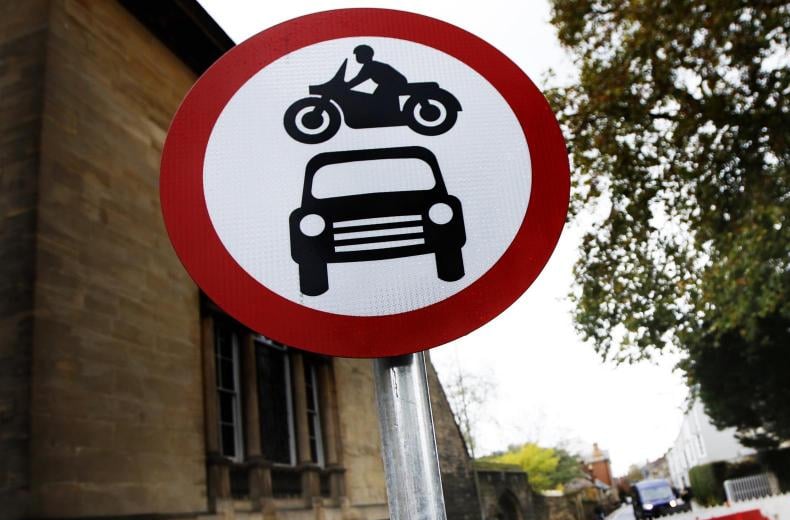
This sign means that you must not drive any motor vehicle down a road where this is displayed. It could be that the area is reserved for pedestrians and cyclists only.
This no motor vehicles sign showing a motorbike over a car is sometimes misunderstood to mean only cars and motorcycles are permitted. Nor does it mean motorcycle stunts aren’t allowed - you can be reasonably confident that they aren’t anyway!
‘No entry for vehicular traffic’ sign

This red circular sign features a white horizontal stripe through the middle to indicate that vehicles aren’t permitted.
Unlike the ‘no motor vehicles’ sign it indicates that cycles and buses are also prohibited from using a road.
‘Traffic has priority over oncoming vehicles’ sign
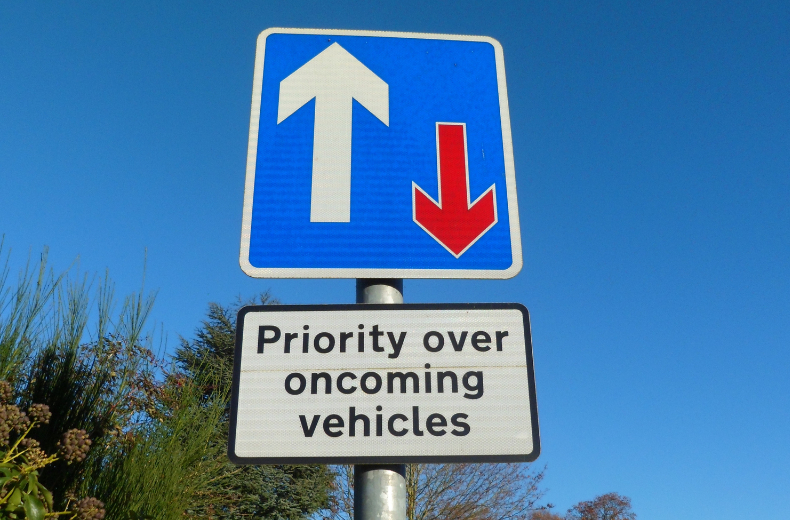
When you see a rectangular blue sign with a large white arrow and small red arrow pointing in opposite directions, it means you have priority over vehicles travelling from the other way. Drivers are often confused by this as it’s not always clear who has right of way.
You’ll commonly see this sign when a road or bridge becomes very narrow, or as part of traffic calming measures where there is only room for one vehicle to pass. If there’s another vehicle travelling towards you that is already in the narrow area, wait for it to pass.
‘T-junction’ sign
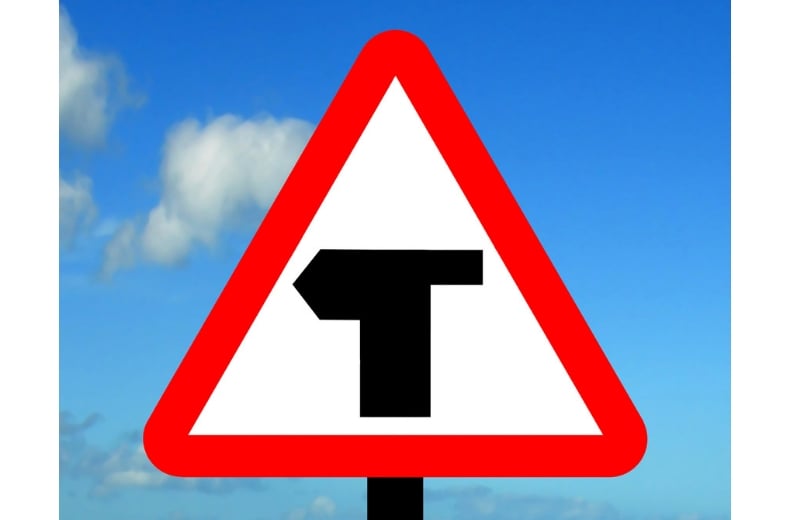
A T-junction is a place where a minor road joins a major one without crossing it, forming the shape of the letter T. The T-junction sign is often placed in busy areas to warn you to be careful as vehicles may be stopping to turn. It can be particularly useful if you’re driving on dark roads at night to let you know you’re approaching a busy junction.
The T-junction sign shouldn’t be confused with the ‘no through road’ sign, which is a blue square with a red and white T shape on it.
‘Traffic queues likely ahead’ sign
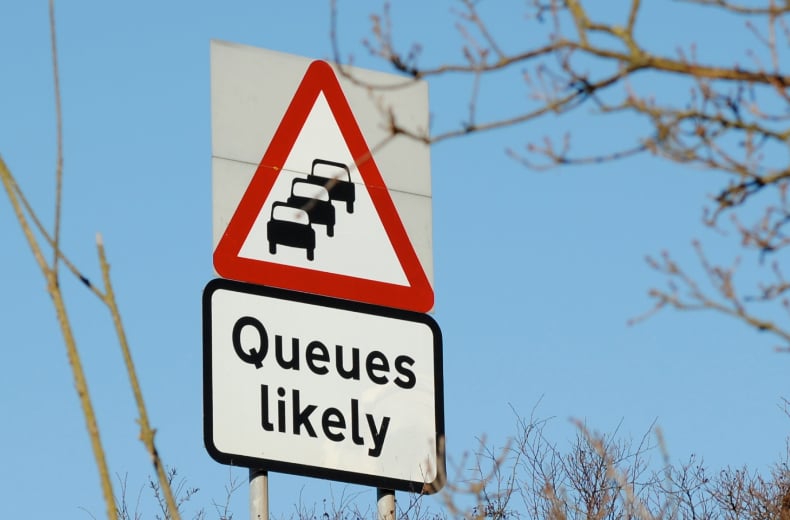
If you see a triangular sign with a row of cars on it, it’s warning you that you’re approaching a congested area, so be prepared to stop.
The queues ahead might be hidden, so make sure you’re aware of vehicles behind you that could be following too closely. If you brake sharply they could run into the back of you, so when you see the sign, start slowing down gradually and brake smoothly.
Driving in stop-start traffic could potentially cause your engine to overheat, so it’s always advisable to have breakdown cover just in case.
Black Box Insurance
Want to pay less for your car insurance? Whether you’re a new driver or just looking to reduce costs, we can help.


‘No overtaking’ sign
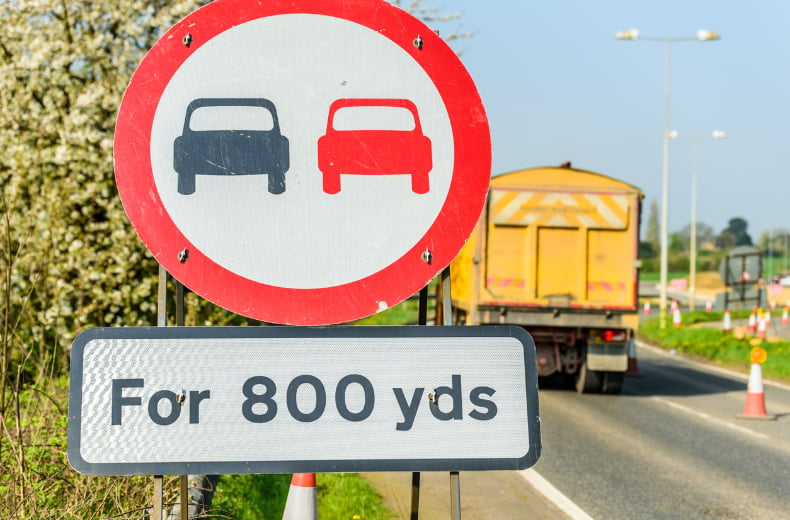
There are several reasons why you might see this sign – it is often displayed when the road has poor visibility or if it’s too narrow for safe overtaking.
It also warns you when there’s a high risk of vehicles pulling out from parking spaces or driveways that would increase the risk of a head-on collision.
- Smart motorways – what are they and how do you use them?
- 16 Highway Code rules you shouldn’t ignore
- Did you know that we offer specialist learner driver insurance?
‘Two-way traffic’ sign
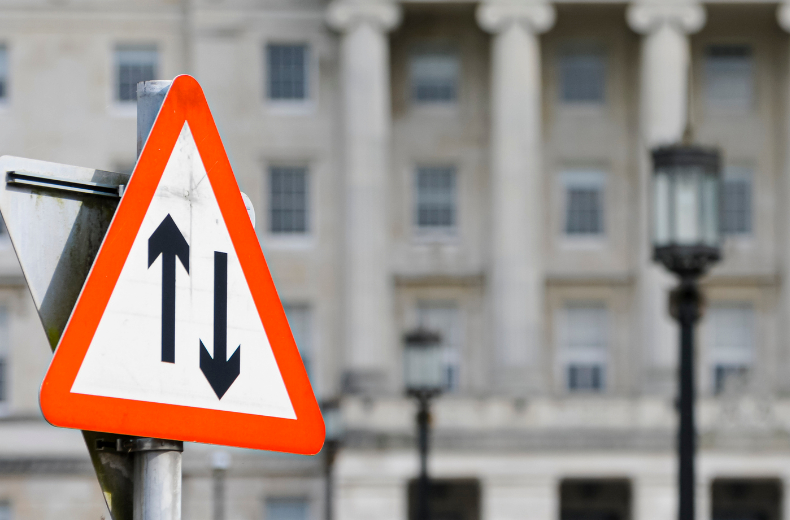
Sometimes you’ll see a red triangular sign with two black arrows pointing in opposite directions. These are used to make you aware that you’re about to leave a separated one-way street and enter a two-way road.
If the arrows are positioned vertically, it means the road you’re driving on will soon carry two-way traffic.
You should keep to the left-hand side of the road and be aware of oncoming traffic. If they’re horizontal, it indicates that you’ll have to turn either left or right to join the two-way road ahead.
‘Slippery road’ sign
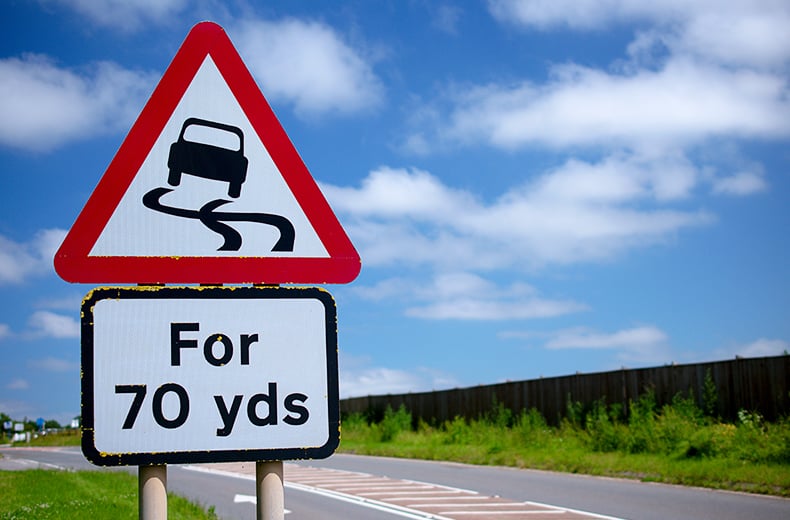
This triangular warning sign shows the silhouette of an out-of-control car and indicates a slippery road ahead.
The sign is often accompanied by a plate reading “For X miles” to prepare you for the full length of a tricky road. Show caution, as traffic authorities are encouraged to use these signs sparingly so their message isn’t undermined.
Learner Driver Car Insurance
Only pay for the cover you need until you’ve passed your test. Get learner driver insurance so you can practice outside of your lessons.


‘Steep hill downwards’/‘Steep hill upwards’ sign
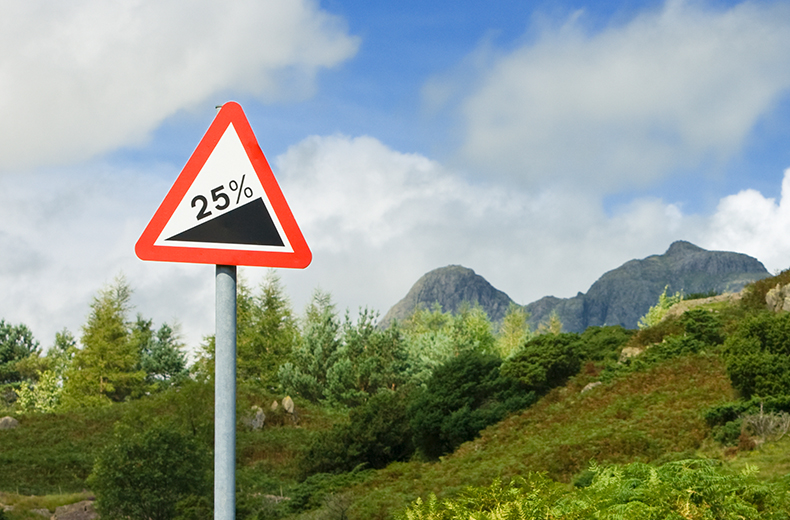
Another warning sign in a red triangle, these are used to alert drivers of hills on the road ahead. Steep hills downward show a decline to the right of the sign, while steep hills upward show an incline to the right of the sign.
The percentage shown refers to the tangent of the angle ahead and is sometimes expressed as a ratio on older signs. You may find that the gradient of a hill becomes steeper as you drive so look out for new signs at all times.
It’s important to stay in a low gear to prevent your engine struggling to deliver more power than necessary.
‘Dual carriageway ends’ sign
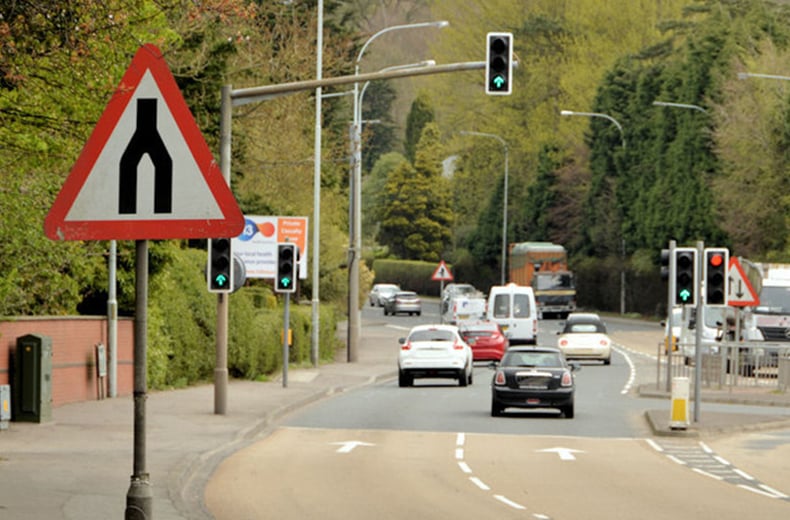
The ‘dual carriageway ends’ sign appears in a red triangle. It shows two carriageways coming together to indicate two-way traffic will continue ahead on a single carriageway road.
You’ll soon notice the central reservation coming to an end and lanes beginning to merge.
‘Road narrows on both sides’ sign
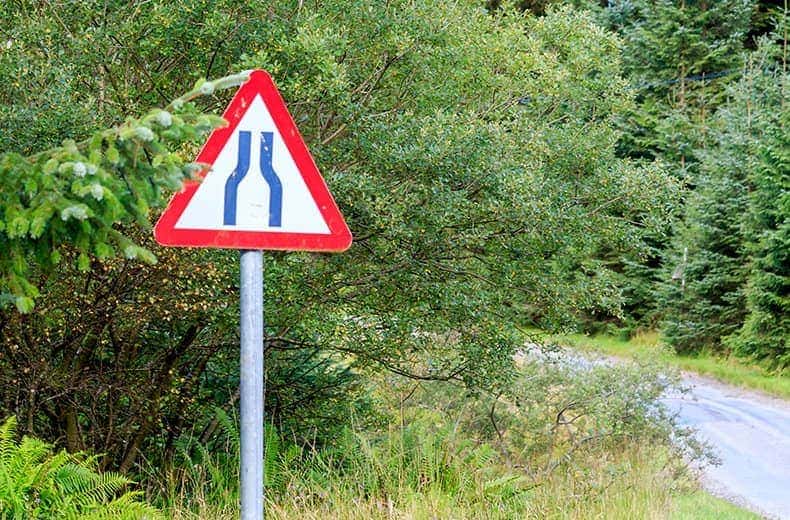
This ‘bottleneck’ sign looks very similar to the ‘dual carriageway ends’ sign, except for one key difference; the vertical lines remain separate despite coming closer together.
Pay special attention to nearby road markings, as the width of lanes will begin to change.
‘Pedestrians in road ahead’ sign
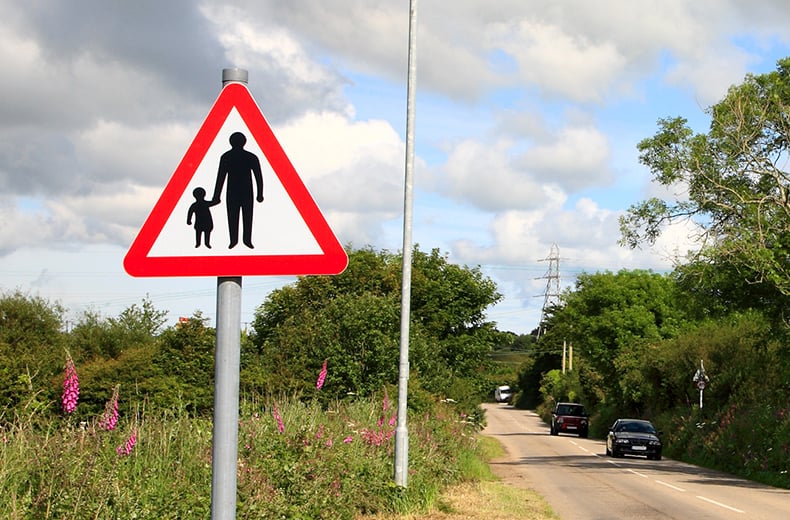
A sign showing the silhouette of an adult and child holding hands lets drivers know that pedestrians might be present on the road ahead. Like other warning signs it appears in a red triangle.
A second sign reading ‘No footway for X yds’ may also feature where pedestrians may be in the road for longer distances.
‘Road humps ahead’ sign
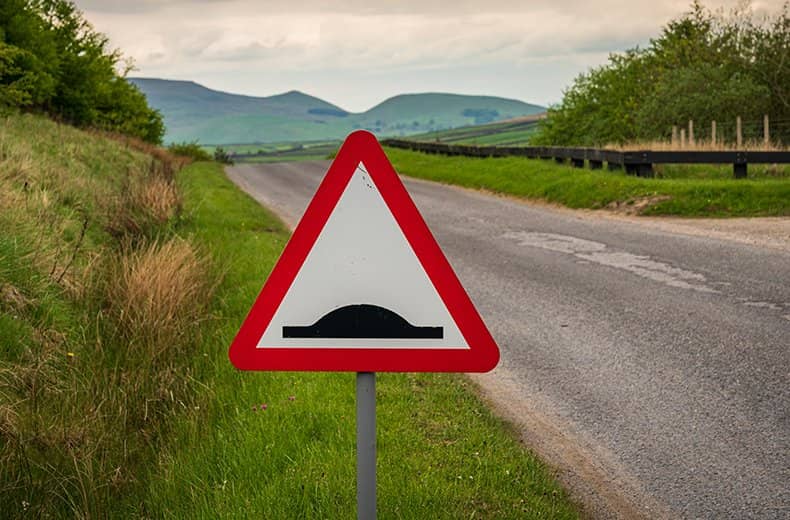
Road hump signs show a humped surface in a red warning triangle. They can be used to indicate a single road hump or a series of humps. The signs must be used with a second plate to indicate the distance road humps cover on a road, or the distance to a road hump.
It’s important to reduce your speed when driving over humps. Some motorists are tempted to speed up between them, but such erratic driving can lead to premature damage to brake pads and suspension.
‘Other danger’ / ‘Hidden dip’ sign
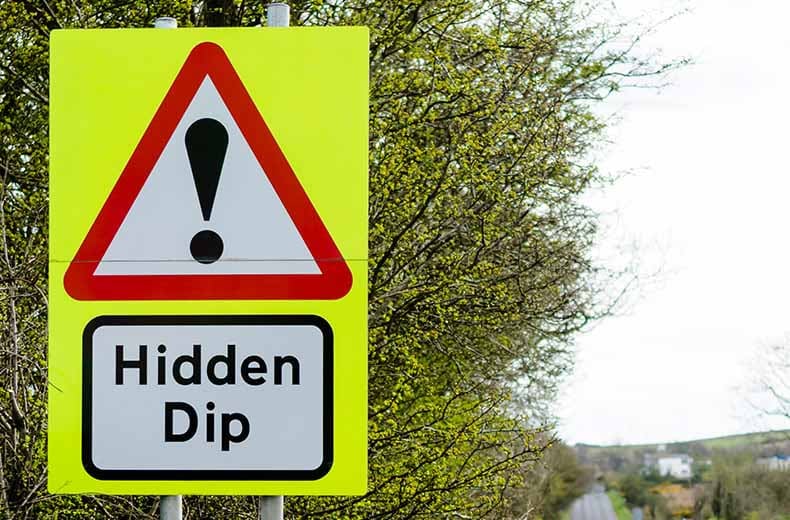
Many drivers believe an exclamation mark in a red triangle is solely used to warn of a hidden dip in the road. However, the sign can indicate any temporary and permanent hazards that aren’t easily represented using symbols.
Remember to drive more cautiously and to keep your eye out for a second sign for more details about the hazard.
‘No vehicles over height shown’ sign
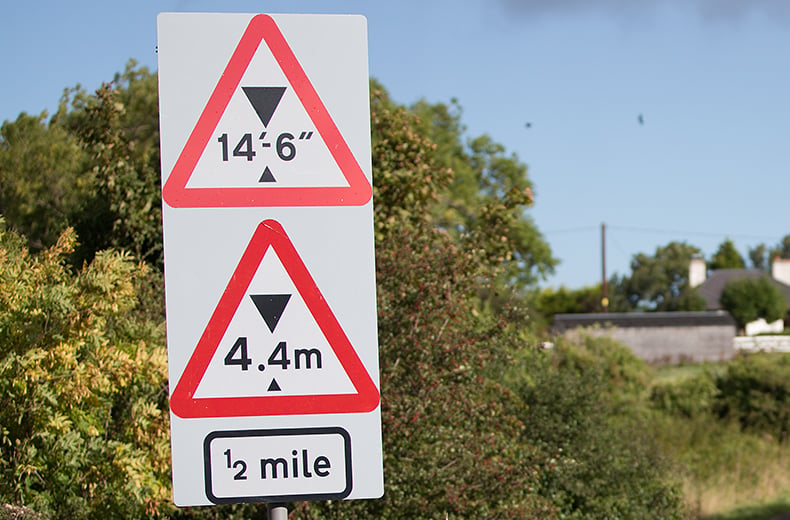
This sign appears in a red triangle with arrows at the top and bottom, and features two measurements. The equivalent imperial and metric measurements let drivers know that vehicles over a certain height should avoid a route – the signs should appear well in advance of the bridge or restriction up ahead.
You might notice a very similar sign on your travels, with arrows at the left and right. These indicate that vehicles over a certain width should avoid a narrow route.
These low clearance signs are also used in red circles, usually on the low bridge itself or a short distance ahead of it:
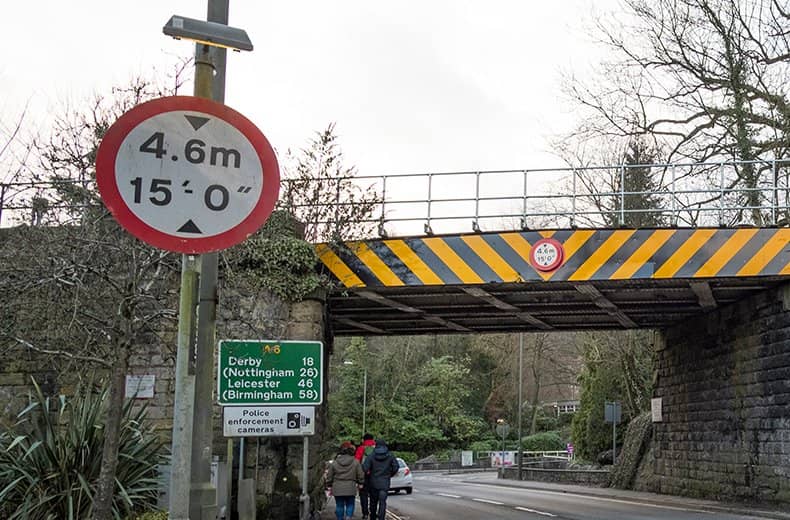
They indicate that it is an offence for over-height vehicles to pass.
Drivers of larger vehicles should look out for signposted diversions once they see the triangular warning sign before they get confronted by the circular restriction sign.
‘No through-road for vehicles’ sign
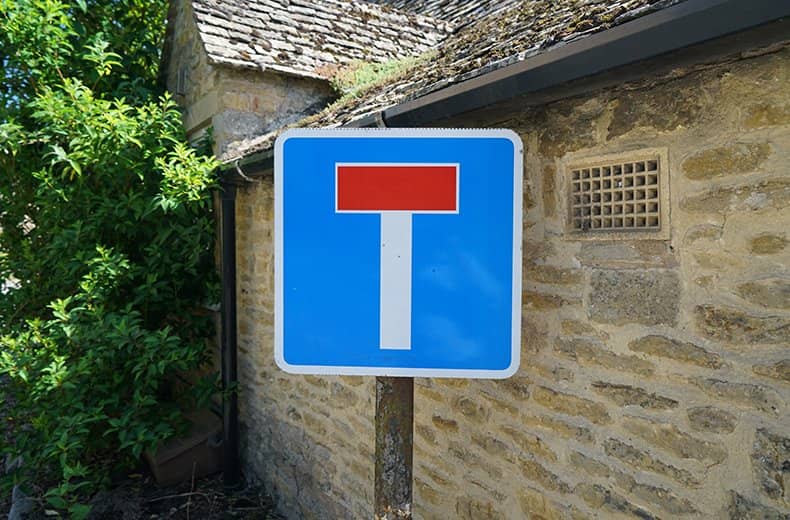
Dead end or ‘no through road’ signs are easily recognised by their horizontal red stripe sat on top of a vertical white stripe. The t-shape appears on a blue background.
The signs are common on residential and smaller roads and should appear next to the road name.
Learning to drive?
If you want to pass your theory test, it's a good idea to learn what each road marking means with an interactive app. Driving Theory Test UK is a great place to start, with all necessary learning materials, hazard perception clips and Highway Code info included. You can download it here:
What do motorway signs mean?
There are a wide range of motorway signs. The Government has published a report that shares what they all mean.
Driving theory test - know your road signs
Before you can drive on the roads, you will need to pass your practical and driving theory test.
We have a wide range of guides that can help you pass your test.
This guide looks at all the ones that you will see in your theory test – but if you have any questions, then let us know in the comments below.
Get 30 driving tips that will save you money
Running a car isn’t cheap, but there are some easy things you can do to keep your costs down. Get these tips and more useful driving articles sent straight to your inbox now.


Services we offer
- Breakdown Cover
- European Breakdown Cover
- Motorbike Breakdown Cover
- Electric Car Breakdown Cover
- Caravan, Motorhome and Campervan Breakdown Cover
- Business Breakdown Cover
- Van Breakdown Cover
- RAC Approved Garages
- Vehicle servicing
- Vehicle repair
- MOTs
- Mobile mechanics
- RAC Tyres
- RAC Approved Dealers
- RAC Shop
- myRAC app


